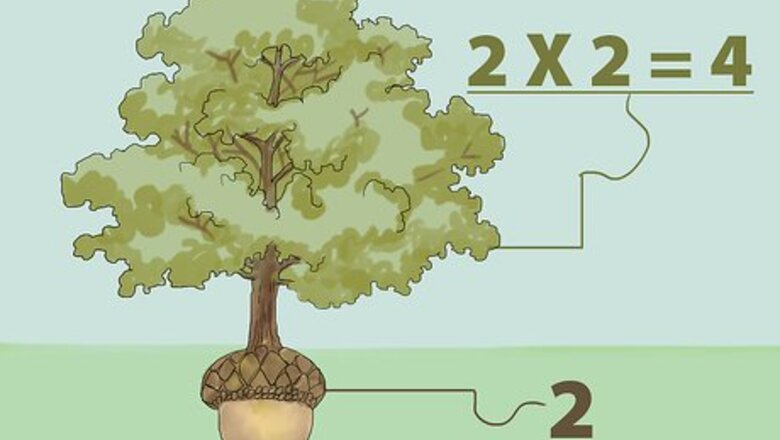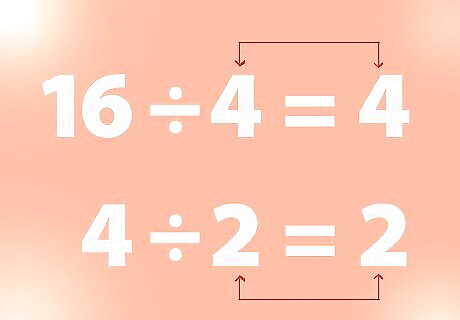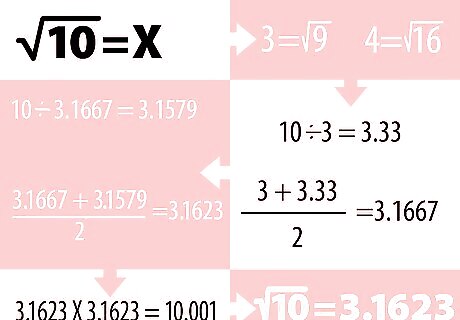
views
X
Research source
Finding the Square Root of Perfect Squares

Figure out the perfect square root using multiplication. The number’s square root is a number that, when multiplied by itself, equals the first number. Another way of saying this is: “What can we multiply by itself to get the number in question?” For example, the square root of 1 is 1 because 1 multiplied by 1 equals 1 (1X1=1). However, the square root of 4 is 2 because 2 multiplied by 2 equals 4 (2X2=4). Think of the square root concept by imagining a tree. A tree grows from an acorn. Thus, it’s bigger than but related to the acorn, which was at its root. In the above example, 4 is the tree, and 2 is the acorn. Thus, the square root of 9 is 3 (3X3=9), of 16 is 4 (4X4=16), of 25 is 5 (5X5=25), of 36 is 6 (6X6=36), of 49 is 7 (7X7=49), or 64 is 8 (8X8=64), of 81 is 9 (9X9=81), and of 100 is 10 (10X10=100).

Use division to find the square root. To find the square root of a whole number, you could also divide the whole number by numbers until you get an answer that is the same as the number you used to divide the whole number. For example: 16 divided by 4 is 4. And 4 divided by 2 is 2, and so on. Thus, in those examples, 4 is the square root of 16, and 2 is the square root of 4. Perfect square roots do not have fractions or decimals because they involve whole numbers.

Use the right symbols for square root. Mathematicians use a special symbol called the radical to indicate square root. It looks like a check mark with a line across the top going to the right. N equals the number whose square root you are trying to find. It goes inside the check mark symbol. Thus, if you are trying to find the square root of 9, you should write a formula that puts the "N" (9) inside the check mark symbol (the "radical") and then present an equal sign and the 3. This means the “square root of 9 equals 3.”
Finding the Square Root of Other Numbers

Take a guess at it, and use the process of elimination. It's tougher to figure out square roots of numbers that are not whole. But it's possible. Let’s say you want to find the square root of 20. You know that 16 is a perfect square with a square root of 4 (4X4=16). Similarly, 25 has a square root of 5 (5X5=25), so the square root of 20 must fall in between 4 and 5. You could guess that 20’s square root is 4.5. Now, simply square 4.5 to check your guess. That means you multiply it by itself: 4.5X4.5. See if the answer is above or below 20. If the guess seems off, simply try another guess (maybe 4.6 or 4.4) and refine your guess until you hit 20. For example, 4.5X4.5 = 20.25, so logically you should try a smaller number, probably 4.4. 4.4X4.4 = 19.36. Thus, the square root of 20 must lie in between 4.5 and 4.4. How about 4.445X4.445. That’s 19.758. It’s closer. If you keep trying different numbers using this process, you will eventually get to 4.475X4.475 = 20.03. Rounding off, that’s 20.

Use a process of averaging. This process also starts with you trying to find the closest whole numbers that your number falls in between. Then, divide your number by one of those square root numbers. Take the answer, and find the average of it and the number you divided by (average is just the sum of those two numbers divided by two). Then take the original number and divide it by the average you got. Finally, find the average of that answer with the first average you got. Sound complicated? It can be easiest to follow an example. For example, 10 lies in between the 2 perfect square numbers of 9 (3X3=9) and 16 (4X4=16). The square roots of those numbers are 3 and 4. So, divide 10 by the first number, 3. You will get 3.33. Now, average the 3 and 3.33 by adding them together and dividing them by 2. You will get 3.1667. Now take 10 divided by 3.1667. The answer is 3.1579. Now, average 3.1579 and 3.1667 by adding them together and dividing the sum you get by two. You will get 3.1623. Check your work by multiplying your answer (in this case 3.1623) by itself. Indeed, 3.1623 multiplied by 3.1623 equals 10.001.

















Comments
0 comment